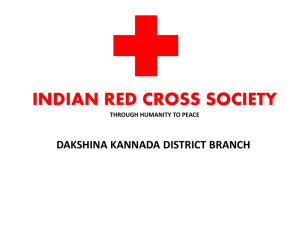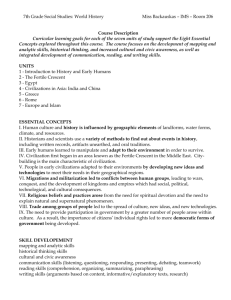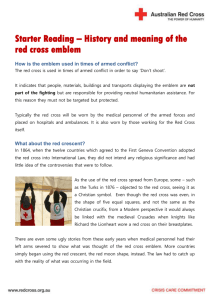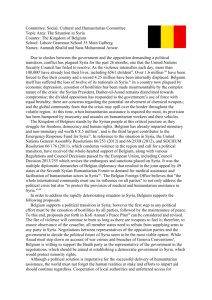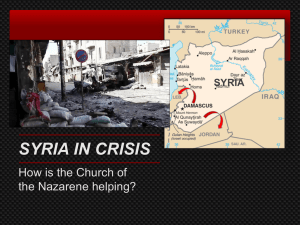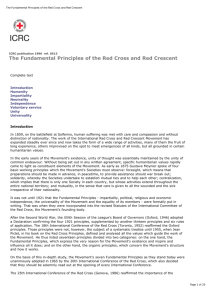Syria Case studies (docx / 120.13 KB)
advertisement
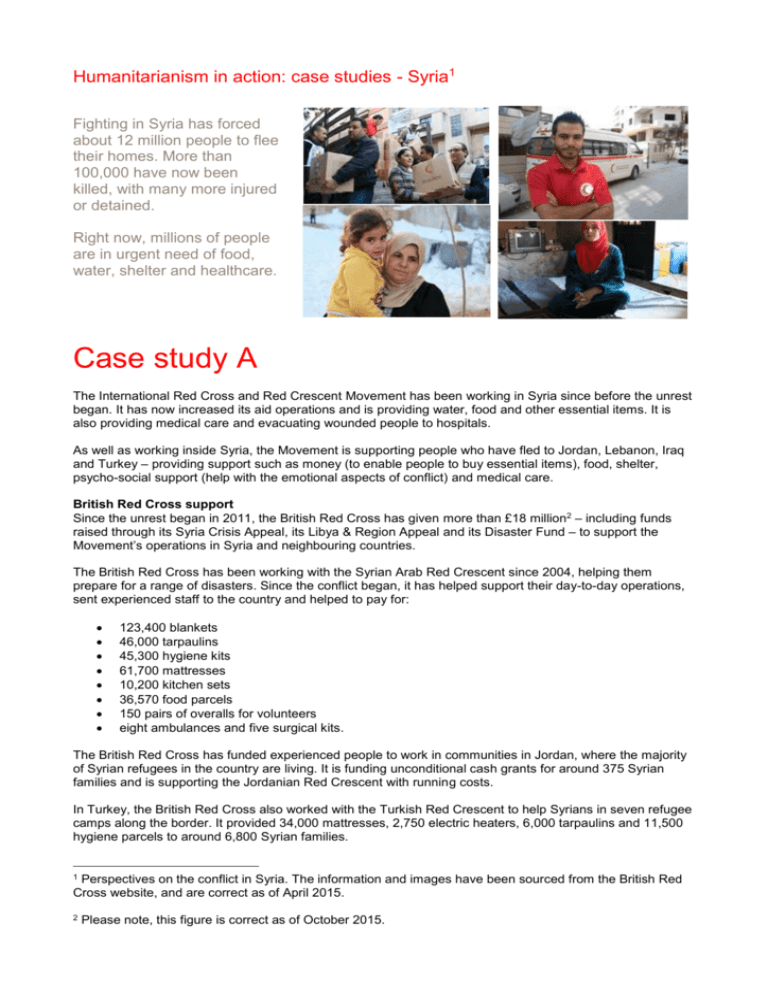
Humanitarianism in action: case studies - Syria1 Fighting in Syria has forced about 12 million people to flee their homes. More than 100,000 have now been killed, with many more injured or detained. Right now, millions of people are in urgent need of food, water, shelter and healthcare. Case study A The International Red Cross and Red Crescent Movement has been working in Syria since before the unrest began. It has now increased its aid operations and is providing water, food and other essential items. It is also providing medical care and evacuating wounded people to hospitals. As well as working inside Syria, the Movement is supporting people who have fled to Jordan, Lebanon, Iraq and Turkey – providing support such as money (to enable people to buy essential items), food, shelter, psycho-social support (help with the emotional aspects of conflict) and medical care. British Red Cross support Since the unrest began in 2011, the British Red Cross has given more than £18 million2 – including funds raised through its Syria Crisis Appeal, its Libya & Region Appeal and its Disaster Fund – to support the Movement’s operations in Syria and neighbouring countries. The British Red Cross has been working with the Syrian Arab Red Crescent since 2004, helping them prepare for a range of disasters. Since the conflict began, it has helped support their day-to-day operations, sent experienced staff to the country and helped to pay for: 123,400 blankets 46,000 tarpaulins 45,300 hygiene kits 61,700 mattresses 10,200 kitchen sets 36,570 food parcels 150 pairs of overalls for volunteers eight ambulances and five surgical kits. The British Red Cross has funded experienced people to work in communities in Jordan, where the majority of Syrian refugees in the country are living. It is funding unconditional cash grants for around 375 Syrian families and is supporting the Jordanian Red Crescent with running costs. In Turkey, the British Red Cross also worked with the Turkish Red Crescent to help Syrians in seven refugee camps along the border. It provided 34,000 mattresses, 2,750 electric heaters, 6,000 tarpaulins and 11,500 hygiene parcels to around 6,800 Syrian families. 1 Perspectives on the conflict in Syria. The information and images have been sourced from the British Red Cross website, and are correct as of April 2015. 2 Please note, this figure is correct as of October 2015. Case study B When stepping out of his front door meant facing a storm of gunfire, Marwan knew he had to leave the area. “The bullets were coming from everywhere. When I went to the roof to check the water tank, they would shoot. If you walked in the street they would shoot. Everyone was shooting, so we had to run away. We didn’t want to leave our lives, and have our homes taken over by strangers. But we made it out, thanks be to God.” Living in a shell Marwan and his family found a place to rent in a small village in northern Lebanon. The unfinished building is far from homely. There are rooms, but no plaster on the walls. There are no doors, no floors and the kitchen barely exists. Marwan is one of more than one million refugees living in Lebanon. ‘Tough’ doesn’t begin to describe life here – there are no official refugee camps and the adults do not have the right to work. The worst thing He’s not used to living like this. He used to own a business, a house and a car. Now he sits on a plastic chair in this shell of a house, wearing sandals and a tracksuit and a defeated expression. “As a father the worst thing is that I can no longer provide for my family. We used to have days out, and go for picnics. Now we can barely eat.” The refugees here rely on charities to get by. The Lebanese Red Cross, a partner of the British Red Cross, is giving Marwan and others cash so they can choose to buy what they most need: food, clothes or rent. Marwan says: “We cannot be proud. I can’t buy clothes for my children. People look at us and can see we are in a bad situation because we cannot dress the children well or send them to school.” The pressure is building Marwan is in limbo, dwelling on the past and unsure what lies ahead. “Before we had money, and services. We had cars; everything was better. I keep asking myself – why did this happen, why has this happened to us? I go over it in my mind and the pressure builds on me. We have heard now that our house is destroyed, the whole area has gone. We don’t know if we’ll ever go back.” Case study C Ibrahim Shukhais was inspired to learn first aid when his own grandmother needed help. Years later, he is using those skills to help people caught up in the Syrian conflict. Ibrahim’s grandmother suffers from ill health and needs constant care. One day she choked on some food and Ibrahim didn’t know what to do. She survived, but afterwards the 21-year-old graduate from Lattakia, Syria, decided to do a first aid course with the Syrian Arab Red Crescent. Inspired by his training, he started volunteering for the organisation in 2011, and joined one of its ambulance teams. A few months ago, they were taking a young man with a broken leg to hospital when they heard that shells had fallen in one of Lattakia’s busy streets. His team were the first people to give help at the scene. Quickly and carefully, they moved people with fractures, badly damaged limbs and shrapnel wounds so they could get further treatment. He says: “It’s a strange feeling, a mix of joy, pride and satisfaction, when I'm the cause of saving someone’s life.” Case study D A news item on ICRC work in Syria3 …earlier today, two Syrian Arab Red Crescent (SARC) volunteers, Ibrahim Eid from the Idlib branch and Mohamad Ahmad Kamouaa from the Maaret al-Nouman sub-branch, were killed while carrying out their duties. "In Syria, as the humanitarian situation deteriorates, Ibrahim and Mohamad's deaths reflect the difficulties and dangers that SARC volunteers and other aid workers are facing there every day." Said Robert Mardini, who heads operations for the International Committee of the Red Cross (ICRC) in the Near and Middle East. "Under no circumstances should aid workers come under attack. They must not be targeted for doing this job. We call for an immediate stop to these attacks," said Elias Ghanem, director of the Middle East and North Africa region for the International Federation of Red Cross and Red Crescent Societies. "In Syria, 424 SARC and eight Palestine Red Crescent volunteers have now lost their lives since the beginning of the conflict, all of them killed while carrying out their humanitarian duties. This is outrageous and unacceptable." The International Red Cross and Red Crescent Movement once again calls upon all parties involved in the conflict in Syria to respect its humanitarian work and guarantee the safety of aid workers and the unimpeded, immediate access to people in need across the country. Without respect for humanitarian workers, ambulances and health facilities, it will become close to impossible to continue saving lives and providing much-needed assistance to millions of Syrians. All parties to conflict are obliged under international humanitarian law to respect medical neutrality and to grant medical personnel, equipment and vehicles safe passage. It is strictly prohibited to attack the staff and volunteers of the International Red Cross and Red Crescent Movement, and all aid workers whose sole purpose is to provide humanitarian relief in emergencies. Further information on the Red Cross and Red Crescent emblems in times of conflict Under international law, civilians should be protected from attacks during armed conflict. Aid workers are also civilians. It is widely accepted that humanitarian relief personnel/aid workers must be respected and protected. It is likely that the Red Crescent volunteers in this article were killed when they were wearing the Red Crescent emblem as part of their uniform. The Red Crescent and Red Cross emblems are protective symbols, indicating the neutrality and the humanitarian mandate/work of Red Crescent and Red Cross volunteers to reach those most in need. The emblems are clearly recognisable to help warring parties (those involved in the conflict) to distinguish between themselves and those providing assistance. The emblems should, in principle, according to international law, provide protection to the impartial Red Cross and Red Crescent humanitarian workers who wear it. 3 Article from 3rd April 2015 Please note, since this article was written the number has increased from 42 to 48 volunteers and is correct as of October 2015. 4
